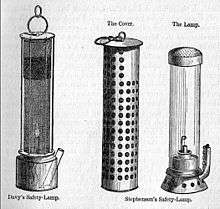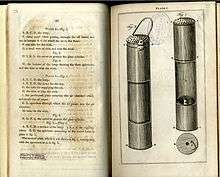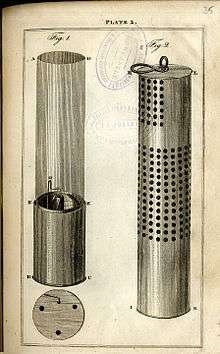Geordie lamp
The Geordie lamp was a safety lamp for use in flammable atmospheres, invented by George Stephenson in 1815 as a miner's lamp to prevent explosions due to firedamp in coal mines.

Origin
In 1815, Stephenson was the engine-wright at the Killingworth Colliery in Northumberland and had been experimenting for several years with candles close to firedamp emissions in the mine. In August he ordered an oil lamp which was delivered on 21 October and tested by him in the mine in the presence of explosive gases. He improved this over several weeks with the addition of capillary tubes at the base so that it gave more light and tried new versions on 4 and 30 November. This was presented to the Literary and Philosophical Society (Lit & Phil) of Newcastle upon Tyne on 5 December 1815.[1]
Although controversy arose between Stephenson's design and the Davy lamp (invented by Humphry Davy in the same year), Stephenson's original design worked on significantly different principles from Davy's final design.[2] If the lamp were sealed except for a restricted air ingress (and a suitably sized chimney) then the presence of dangerous amounts of firedamp in the incoming air would (by its combustion) reduce the oxygen concentration inside the lamp so much that the flame would be extinguished. (Stephenson had convinced himself of the validity of this approach by his experiments with candles near lit blowers: as lit candles were placed upwind of the blower the blower flame grew duller; with enough upwind candles the blower flame went out.)[3] To guard against the possibility of a flame travelling back through the incoming gases (an explosive backblast), air ingress was by a number of small-bore orifices through which the air flowed at a velocity higher than the velocity of the flame in a mixture of firedamp (mostly methane) and air. The body of the lamp was lengthened to give the flame a greater convective draw, and thus allow a greater inlet flow restriction and make the lamp less sensitive to air currents. Davy had originally attempted a safety lamp on similar principles, before preferring to enclose the flame inside a brass gauze cylinder; he had publicly identified the importance of allowing the restricted airflow in through small orifices (in which the flame velocity is lower) before Stephenson had, and he and his adherents remained convinced that Stephenson had not made this discovery independently.[4][lower-alpha 1]
Two advantages of Stephenson's design over Davy's was that if the proportion of firedamp became too high, his lamp would be extinguished, whereas Davy's lamp could become dangerously hot. This was illustrated in the Oaks colliery at Barnsley on 20 August 1857 where both types of lamp were in use.[7]
Stephenson's design used paper to surround the flame, which cut out less of the light than Davy's, where the gauze surrounded it.[8] But this also posed the danger of breakage in the harsh conditions of mineworking, a problem which was not resolved until the invention of safety glass. Stephenson tried several different designs in early years and later adopted Davy's gauze in preference to the tubes and it was this revised design that was used for most of the 19th century as the Geordie lamp.
The Geordie lamp continued to be used in the north-east of England through most of the 19th century, until the introduction of electric lighting.


Notes
- The mean maximum quenching diameter (the maximum hole diameter through which a flame (not an explosion) will not pass: this places no reliance on the flow velocity through the hole) for drilled holes in 1/32" thick brass plate was reported in 1968 to be 0.139 inches for methane/air mixtures.[5] Stephenson's first lamp had a 1/2" air inlet, throttled by a slider, the second three air inlets of internal diameter 3/22" (0.136") but distorted by bending at the tip to give an oval, long diameter 1/5", short diameter 1/14", in his third lamp, air ingress was through brass plates with holes of various sizes, the largest about 1/12" diameter[6]
References
- Smiles 1862, pp. 119–127.
- Stephenson 1817.
- Smiles 1857, p. 103.
- Paris 1831, pp. 88 ff.
- Grove 1968, p. 53.
- Brandling 1817.
- Smiles 1862, p. 126–128.
- E. Thomas & Williams Ltd.
Bibliography
- Brandling, C J (chair) (1817), Report upon the claims of Mr. George Stephenson, relative to the invention of his safety lamp, by the committee appointed at a meeting holden in Newcastle on the First of November 1817, Newcastle: Emerson Charnley
- E. Thomas & Williams Ltd, Original Types of Miners' Flame Safety Lamps, Welshminerslamps.com, archived from the original on 1 February 2013, retrieved 9 March 2013
- Grove, J R (1968), "The Measurement of Quenching Diameters and their Relation to the Flameproof Grouping of Gases and Vapours" (PDF), Third Symposium on chemical process hazards with special reference to plant design LChem.E. Symposium Series, London: Institution of Chemical Engineers, 25: 53, archived from the original (PDF) on 11 October 2017, retrieved 30 April 2017
- Paris, John Ayrton (1831), The Life of Sir Humphry Davy, Late President of the Royal Society, Foreign Associate of the Royal Institute of France ...: In 2 volumes, Colburn & Bentley
- Smiles, Samuel (1857), The Life of George Stephenson, Railway Engineer, London: John Murray
- Smiles, Samuel (1862), Lives of the Engineers, III This is in part a revised edition of the earlier Life of George Stephenson.
- Stephenson, George (1817), A description of the safety lamp, invented by George Stephenson, retrieved 9 March 2013